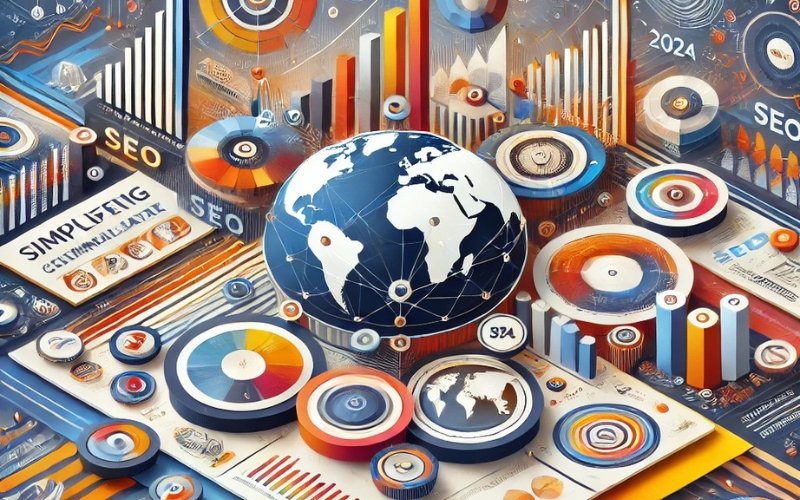In 2024, infographics remain one of the most powerful tools for Simplifying complex data into an easily digestible format. These visually appealing designs are excellent for breaking down detailed information, making it simpler for audiences to understand at a glance. Not only do infographics make your content more accessible, but they are also highly shareable, making them a valuable asset in any content marketing and SEO strategy.
Why Infographics Work for SEO

Visual Appeal
Infographics are powerful tools that combine text, visuals, and data to create engaging content that captures attention. In a digital world dominated by lengthy paragraphs and dense information, infographics stand out by simplifying complex data into visually digestible formats. The strategic use of colors, icons, graphs, and charts not only makes information easier to understand but also ensures the content resonates with diverse audiences. This approach helps businesses effectively communicate statistics, trends, or other data-heavy topics without overwhelming their readers.
One of the key advantages of infographics is their ability to simplify complex data into easily comprehensible visuals. By breaking down intricate concepts into bite-sized pieces, infographics make it possible for users to grasp important points quickly. This is especially valuable for organizations aiming to present technical or analytical information to non-expert audiences.
Moreover, the visual appeal of infographics boosts their shareability across platforms like Instagram, Pinterest, and Twitter. These visually rich assets are more likely to be shared, thereby increasing website traffic and generating backlinks—two critical components for improving SEO performance. Through simplifying complex data, businesses not only make their content more accessible but also enhance their digital reach and visibility.
In essence, the visual charm of infographics lies in their ability to simplify complex data while maintaining an aesthetic appeal that encourages engagement, retention, and shareability.
Easy-to-Digest Information
One of the greatest strengths of infographics is their ability to condense complex information into bite-sized pieces, making it more accessible for users. In today’s fast-paced digital environment, audiences often lack the time or patience to sift through dense text or lengthy reports. Infographics excel at simplifying complex data, presenting key insights in a visually engaging format that captures attention quickly. This is especially valuable when dealing with intricate topics like statistics, research findings, or industry trends, where clarity is essential.
By breaking down these complexities, infographics ensure that users not only grasp the key points but also retain the information for longer. For example, a well-designed infographic on industry trends can illustrate patterns, percentages, and timelines more effectively than paragraphs of text. This ability to simplify complex data is what makes infographics a favorite tool for marketers, educators, and businesses alike.
Moreover, engaging infographics encourage users to spend more time on your page, which reduces bounce rates and signals to search engines that your content is both relevant and valuable. The longer users engage with your content, the higher the likelihood of improving your search rankings. Whether shared on social media or embedded in blog posts, infographics provide a powerful means of simplifying complex data while boosting your digital visibility.
Embedded Links
One of the standout advantages of infographics is their ability to drive referral traffic through embedded links. These links are a powerful tool for increasing visibility and engagement, especially when your infographic is shared across various platforms. When an infographic is embedded on other websites, the embedded links often direct users back to your original page, creating a seamless pathway for referral traffic. This not only amplifies your reach but also builds connections with a broader audience. More importantly, embedded links are a key factor in boosting your website’s domain authority.
Search engines like Google prioritize backlinks from reputable sources as indicators of high-quality content. By leveraging infographics that focus on simplifying complex data, you not only provide valuable insights to your audience but also encourage other sites to link back to your content. The ability to simplify complex data into an engaging, visually appealing format makes infographics an indispensable asset in any content marketing strategy. Additionally, infographics excel at simplifying complex data, making it easier for your audience to grasp detailed information quickly. This approach to simplifying complex data drives higher engagement and enhances the value of your content.
The Evergreen Advantage of Infographics

What sets infographics apart from other types of content is their evergreen appeal. Unlike blogs or social media posts that may lose relevance over time, a well-designed infographic retains its value and continues to attract attention for years. The reason for this longevity lies in its core function—simplifying complex data into digestible, actionable insights. Infographics present information in a way that is universally accessible, regardless of the audience’s technical expertise.
This lasting relevance ensures that your infographic keeps generating backlinks and driving traffic long after its initial publication. For instance, educators often use infographics as teaching aids, while bloggers cite them to support their arguments. Marketers appreciate their shareability, using them in presentations, newsletters, and social media campaigns. This continued use magnifies the impact of the embedded links, reinforcing your content’s authority while also simplifying complex data for diverse audiences.
Amplifying the Impact with Embedded Links
The ability to embed links in infographics creates a ripple effect that extends beyond immediate traffic gains. By focusing on simplifying complex data, you position your content as a trusted resource that others want to reference. This trust translates into higher shareability and increased backlink opportunities. Each embedded link serves as a vote of confidence in your content’s quality, improving your website’s SEO rankings and driving more organic traffic.
Moreover, when your infographics focus on simplifying complex data, they resonate with professionals across various industries, from academics and researchers to marketers and consultants. This cross-industry appeal broadens your audience base and ensures your content’s long-term success. By embedding links into infographics, you not only increase visibility but also reinforce your brand’s credibility as an authority in your niche..
Best Practices for Creating Effective Infographics

Infographics are powerful tools for conveying information in a visually engaging way, but their effectiveness depends on how they are crafted and presented. Following best practices ensures your infographics deliver value, attract engagement, and improve your website’s SEO performance. Here are expanded insights into these practices, emphasizing the importance of simplifying complex data to make it accessible and impactful.
Focus on Quality
The quality of your infographic is paramount to its success. A well-designed infographic is visually appealing, informative, and easy to understand. Pay attention to design elements such as color schemes, typography, and layout to create an attractive and professional look. Remember, infographics are often shared on social media and other platforms, so a polished design increases the likelihood of engagement.
Equally important is ensuring the accuracy and clarity of the data you present. Infographics are about simplifying complex data into digestible, visually engaging chunks. Misleading or incorrect information can damage your credibility, while overly complicated visuals might confuse your audience. Invest in thorough research and fact-checking to build trust and enhance the infographic’s value.
Keep It Relevant
Relevance is a key factor in the success of any infographic. To resonate with your audience, align your content with their interests and needs. Understand their pain points and craft infographics that address specific questions, solve problems, or provide actionable insights. By doing so, you increase the likelihood of your content being shared, bookmarked, and revisited.
Additionally, relevance extends to the data you include. Focus on simplifying complex data that might otherwise overwhelm your audience. For example, use clear headings, concise explanations, and straightforward charts or graphs to make the information easy to digest. A relevant and user-centric infographic can establish your authority in your niche while delivering real value to your audience.
Optimize for SEO
Infographics offer significant SEO benefits when optimized effectively. Incorporate keywords in critical elements such as the title, description, and alt text. For instance, if your infographic is about “Trends in Digital Marketing,” include related keywords naturally in these areas to improve search engine visibility.
In addition to keyword optimization, ensure your infographic is mobile-friendly. Many users access content on smartphones, so responsive design is essential. Use scalable graphics and fonts that maintain readability across different screen sizes. By focusing on simplifying complex data, you can make your infographic accessible to a broader audience, boosting both engagement and SEO performance.
Add Context and Narrative
An infographic is more impactful when it tells a story. Avoid simply presenting numbers or isolated data points. Instead, organize the information in a logical flow that guides the viewer through a narrative. Begin with an attention-grabbing headline or statistic, follow with supporting visuals, and conclude with a strong takeaway.
Simplifying complex data into a coherent story makes the content memorable and easy to share. For example, if you’re illustrating how a process works, use numbered steps and minimal text to break it down into manageable pieces. This approach helps viewers quickly understand the content without feeling overwhelmed.
Promote Sharing and Accessibility
An effective infographic is one that reaches a wide audience. Make sharing easy by including social media buttons and embedding options on your website. Additionally, provide a brief written summary alongside the infographic to improve its accessibility for search engines and visually impaired users.
When promoting your infographic, emphasize how it excels in simplifying complex data to deliver value. This positions your content as a useful resource, increasing its likelihood of being shared widely and generating backlinks, which are crucial for SEO
Conclusion
Infographics are a powerful SEO tool in 2024, combining visual appeal with the ability to present complex information in a simple and engaging format. Their shareability, capacity to generate backlinks, and ability to keep users engaged make them an essential part of any content marketing strategy. By focusing on quality, relevance, and SEO optimization, you can leverage infographics to boost your website’s visibility and authority in search engine rankings.

